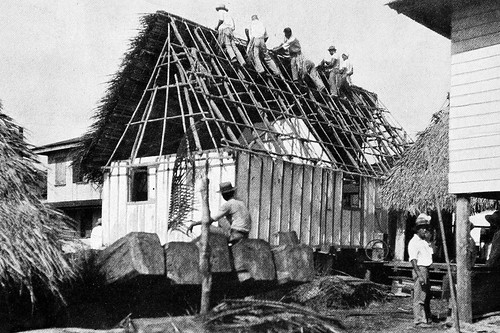Chenchule’: Social Reciprocity
Social reciprocity
Chenchule’ refers to the intricate system of social reciprocity at the heart of ancient and contemporary CHamoru society. Chenchule’ is a support system of exchange in which families express their care and concern for each other, as well as a sense of obligation to each other while working together to help each family meet its needs. It signifies the core CHamoru value of mutuality expressed in innumerable ways and is meant to sustain the integrity of the CHamoru family and community.
Chenchule’ is further rooted in the core value of inafa’maolek that promotes interdependence within the community so as to provide for the well-being of the whole, rather than that of the individual.
In the past chenchule’ referred to the act of giving, but has come to refer to the contribution itself as well. CHamorus on Guam have begun to use the term chenchule’ to describe many types of reciprocation. Up until recent times, CHamorus were more likely to use specific terms to distinguish the various types of assistance exchanged.
These terms helped to identify the type of event it was for, described that it was a form of labor, indicated that it was tangible (touchable), or provided other details. For example, the offering at a baptism reception or child’s birthday might have been labeled regalu, while assistance at funerals given by close friends of the same generation would have been more commonly called ika.
Help and support system
The central theme of chenchule’ has remained strong through the years. CHamorus feel compelled to help and support one another through times of both celebration and grieving. CHamorus also gain a sense of social esteem through fulfilling such obligations or through being able to publicly demonstrate the amount of assistance available to them. Part of one’s CHamoru identity rests on the particular system of reciprocal obligation of which one’s family is a part.
In ancient times, certain reciprocation would have taken the form of ålas, or traditional turtle shell valuables, given in exchange for some special service performed or favor bestowed. As CHamoru society transformed into a money-based economy, this living practice of reciprocity transformed as well.
Chenchule’ today is demonstrated most obviously at celebrations of life milestones—taking the form of different types of labor, food, drink or other supply contributions, gifts, or money at occasions such as weddings, childbirth, and funerals. At such events, a chenchule’ box usually graces the gift table, decorated in a specific design (such as a treasure chest, water well, or theme character) or is otherwise made attractive. Guests insert envelopes of money, labeled with their family names and oftentimes village of residence, through a slot on the box’s top. At weddings, chenchule’ can also be found on the dance floor during a money dance in which guests line up to dance with the bride or groom and pin paper money onto the newlywed’s garments during their turn.
Over the years, CHamoru life-cycle events have become celebrated more often and have become more elaborate. Money has become a favored form of chenchule’, however, the contribution of labor, food, drink, and other supplies for a celebration remain a widely practiced form of chenchule’. Chenchule’ is now often documented in writing among families, recording the date of the contribution and its type and amount. This partially developed as a way to track contributions so that the receiving party would equitably reciprocate the giving party during a future time of need.
Further, this tracking system was developed to recognize all those who have given from the heart – the most valuable aspect of chenchule’. Chenchule’ debts—both those owed and to be paid, are inherited by the next generation. The ongoing nature of chenchule’ between generations within a family works to strengthen and sustain ties of mutual obligation and support between CHamoru families.
By Kelly G. Marsh-Taitano and Julian Aguon
For further reading
Chamorro Heritage, A Sense of Place: Guidelines, Procedures and Recommendations For Authenticating Chamorro Heritage. The Hale’-ta Series. Hagåtña: Department of Chamorro Affairs, Research, Publication, and Training Division, 2003.
Cunningham, Lawrence J. Ancient Chamorro Society. Honolulu: Bess Press, 1992.
Herman, RDK. “Guam: Inarajan – Footprints: Chenchule’,” 2003.
I Ma Gobetna-na Guam: Governing Guam Before and After the Wars. The Hale’-ta Series. Hagåtña: Political Status Education Coordinating Commission, 1994.
Iyechad, Lilli Perez. “Death: The Expression of Grief.” In An Historical Perspective of Helping Practices Associated with Birth, Marriage and Death Among Chamorros in Guam. Lewiston: Edwin Mellen Press, 2001.


